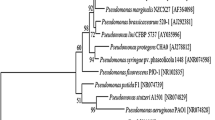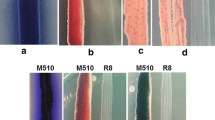Abstract
Background and Aims
Intensifying chemotactic rhizocompetence is an effective approach to improving PGPR colonization in the plant rhizosphere and promoting plant growth. Whether increasing the efficient adaptational methylation modification of chemoreceptors enhances chemotactic rhizocompetence is unknown. Pseudomonas sp. UW4 is a typical PGPR, and 1-aminocyclopropane-1-carboxylic acid (ACC) is the strong chemoattractant that directs it to the rhizosphere.
Methods
The chemoreceptor pentapeptide involved in UW4 chemotaxis were identified through molecular docking and methylation reactions in vitro. The pentapeptide was identified as PEKPR residing in the C-terminus of the chemoreceptor Mcp14 and shows no sequence conservation with that of other bacteria. Two chemoreceptor mutants were constructed: in one, the pentapeptide was additionally grafted to the ACC chemoreceptor McpACC (UW4-1); in the other, the pentapeptide was transferred to McpACC (UW4-2).
Results
UW4-1 and UW4-2 showed unchanged chemotactic responses to arginine and succinic acid compared to UW4, whereas the chemotactic responses of UW4-1 to ACC were 36.0% and 17.2% higher than those of UW4 and UW4-2, respectively. Wheat rhizosphere colonization by UW4-1 in nonaxenic pot trials was 62.0% and 14.3% higher than rhizosphere colonization by UW4 and UW4-2, respectively, and the root and shoot dry weights of wheat inoculated with UW4-1 were 10.3% and 5.5% and 16.5% and 13.2% higher, respectively, than those of wheat inoculated with UW4 and UW4-2.
Conclusion
Grafting the pentapeptide to the chemoreceptor corresponding to the strong rhizosphere chemoattractant for PGPR increases PGPR chemotactic response to the strong rhizosphere chemoattractant, increases plant rhizosphere colonization, and leads to higher plant growth promotion.






Similar content being viewed by others
Data Availability
All data generated during this study are included in full in this paper and its supplementary information files.
References
Antommattei FM, Weis RM (2006) Reversible methylation of glutamate residues in the receptor proteins of bacterial sensory systems. In: Clarke SG, Tamanoi F (eds) The Enzymes: Protein Methyltransferases, vol 24. Academic Press, San Diego, pp 325–381
Arnold K, Bordoli L, Kopp J, Schwede T (2006) The SWISS-MODEL workspace: a web-based environment for protein structure homology modelling. Bioinformatics 22:195–201
Barnakov AN, Barnakova LA, Hazelbauer GL (2001) Location of the receptor-interaction site on CheB, the methylesterase response regulator of bacterial chemotaxis. J Bio Chem 276:32984–32989
Barquero M, Pastor-Buies R, Urbano B, González-Andrés F (2019) Challenges, Regulations and Future Actions in Biofertilizers in the European Agriculture: From the Lab to the Field. In: Zúñiga-Dávila D, González-Andrés F, Ormeño-Orrillo E (ed) Microbial Probiotics for Agricultural Systems. Sustainability in Plant and Crop Protection. Springer, Cham, pp 83–107
Biasini M, Bienert S, Waterhouse A, Arnold K, Studer G, Schmidt T, Kiefer F, Cassarino TG, Bertoni M, Bordoli L, Schwede T (2014) SWISS-MODEL: Modelling protein tertiary and quaternary structure using evolutionary information. Nucleic Acids Res 42:W252–W258
Carroll D, Holden N, Gifford ML, Dupuy LX (2020) Framework for quantification of the dynamics of root colonization by Pseudomonas fluorescens isolate SBW25. Front Microbiol 11:2403
Dekkers LC, Bloemendaal CJP, de Weger LA, Wijffelman CA, Spaink HP, Lugtenberg BJ (1998) A two-component system plays an important role in the root-colonizing ability of Pseudomonas fluorescens strain WCS365. Mol Plant-Microbe Interact 11:45–56
Djordjevic S, Stock AM (1997) Crystal structure of the chemotaxis receptor methyltransferase CheR suggests a conserved structural motif for binding S-adenosylmethionine. Structure 5:545–558
Djordjevic S, Stock AM (1998) Chemotaxis receptor recognition by protein methyltransferase CheR. Nat Struct Biol 5:446–450
Djordjevic S, Goudreau PN, Xu Q, Stock AM, West AH (1998) Structural basis for methylesterase CheB regulation by a phosphorylation-activated domain. Proc Natl Acad Sci USA 95:1381–1386
Duan J, Jiang W, Cheng Z, Heikkila JJ, Glick BR (2013) The complete genome sequence of the plant growth-promoting bacterium Pseudomonas sp. UW4. PloS One 8:e58640
Feng X, Baumgartner JW, Hazelbauer GL (1997) High- and low-abundance chemoreceptors in Escherichia coli: differential activities associated with closely related cytoplasmic domains. J Bacteriol 179:6714–6720
Feng X, Lilly AA, Hazelbauer GL (1999) Enhanced function conferred on low-abundance chemoreceptor Trg by a methyltransferase-docking site. J Bacteriol 181:3164–3171
Froimowitz M (1993) HyperChem: a software package for computational chemistry and molecular modeling. Biotechniques 14:1010–1013
Gao X, Li T, Liu W, Zhang Y, Shang D, Gao Y, Qi Y, Qiu L (2020) Enhancing the 1-aminocyclopropane-1-carboxylate metabolic rate of Pseudomonas sp. UW4 intensifies chemotactic rhizocompetence. Microorganisms 8:71
García-Fontana C, Lugo AC, Krell T (2014) Specificity of the CheR2 methyltransferase in Pseudomonas aeruginosa is directed by a C-terminal pentapeptide in the McpB chemoreceptor. Sci Signal 7:ra34–ra34
Glick BR (2012) Plant growth-promoting bacteria: mechanisms and applications. Scientifica 963401
Harris SL, Pelaez CA, Shank EA (2019) Monitoring bacterial colonization and maintenance on Arabidopsis thaliana roots in a floating hydroponic system. JoVE 147:e59517
Hoang TT, Karkhoff-Schweizer RR, Kutchma AJ, Schweizer HP (1998) A broad-host-range Flp-FRT recombination system for site-specific excision of chromosomally-located DNA sequences: application for isolation of unmarked Pseudomonas aeruginosa mutants. Gene 212:77–78
Ji SH, Kim JS, Lee CH, Seo HS, Chun SC, Oh J, Choi EH, Park G (2019) Enhancement of vitality and activity of a plant growth-promoting bacteria (PGPB) by atmospheric pressure non-thermal plasma. Sci Rep 9:1–16
Lai W, Hazelbauer GL (2005) Carboxyl-terminal extensions beyond the conserved pentapeptide reduce rates of chemoreceptor adaptational modification. J Bacteriol 187:5115–5121
Lewenza S, Conway B, Greenberg EP, Sokol PA (1999) Quorum sensing in Burkholderia cepacia: identification of LuxRI homogs CepRI. J Bacteriol 181:748–756
Li M, Hazelbauer GL (2005) Adaptational assistance in clusters of bacterial chemoreceptors. Mol Microbiol 56:1617–1626
Li J, Li G, Weis RM (1997) The serine chemoreceptor from Escherichia coli is methylated through an inter-dimer process. Biochemistry 36:11851–11857
Li J, Ovakim DH, Charles TC, Glick BR (2000) An ACC deaminase minus mutant of Enterobacter cloacae UW4 no longer promotes root elongation. Curr Microbiol 41:101–105
Li T, Zhang J, Shen C, Li H, Qiu L (2019) 1-aminocyclopropane-1-carboxylate: a novel and strong chemoattractant for the plant beneficial rhizobacterium Pseudomonas putida UW4. Mol Plant-Microbe Interact 32:750–759
Li T (2019) 1-Aminocyclopropane-1-carboxylate: the key chemoattractant for Pseudomonas putida UW4 colonization at crop rhizosphere. Doctoral thesis Henan Agricultural University
Lybarger SR, Nair U, Lilly AA, Hazelbauer GL, Maddock JR (2005) Clustering requires modified methyl-accepting sites in low-abundance but not high-abundance chemoreceptors of Escherichia coli. Mol Microbiol 56:1078–1086
Majeed A, Muhammad Z, Ahmad H (2018) Plant growth promoting bacteria: role in soil improvement, abiotic and biotic stress management of crops. Plant Cell Rep 37:1599–1609
Morris GM, Huey R, Lindstrom W, Sanner MF, Belew RK, Goodsell DS, Olson AJ (2009) AutoDock4 and AutoDockTools4: Automated docking with selective receptor flexibility. J Comput Chem 30:2785–2791
Muppirala UK, Desensi S, Lybrand TP, Hazelbauer GL, Li Z (2009a) Molecular modeling of flexible arm-mediated interactions between bacterial chemoreceptors and their modification enzyme. Protein Sci 18:1702–1714
Muppirala UK, Desensi S, Lybrand TP, Hazelbauer GL, Li Z (2009b) Molecular modeling of flexible armmediated interactions between bacterial chemoreceptors and their modification enzyme. Protein Sci 18:1702–1714
Okumura H, Nishiyama SI, Sasaki A, Homma M, Kawagishi I (1998) Chemotactic adaptation is altered by changes in the carboxy-terminal sequence conserved among the major methyl-accepting chemoreceptors. J Bacteriol 180:1862–1868
Perez E, Stock AM (2007) Characterization of the Thermotoga maritima chemotaxis methylation system that lacks pentapeptide-dependent methyltransferase CheR: MCP tethering. Mol Microbiol 63:363–378
Pizarro-Tobías P, Udaondo Z, Roca A, Ramos J (2015) Events in root colonization by Pseudomonas putida. In: Ramos JL, Goldberg J, Filloux A (eds) Pseudomonas. Springer, Dordrecht, pp 251–286
Qiu Z, Egidi E, Liu H, Kaur S, Singh BK (2019) New frontiers in agriculture productivity: Optimised microbial inoculants and in situ microbiome engineering. Biotechnol Adv 37:107371
Rosier A, Medeiros FHV, Bais HP (2018) Defining plant growth promoting rhizobacteria molecular and biochemical networks in beneficial plant-microbe interactions. Plant Soil 428:35–55
Sarand I, Österberg S, Holmqvist S, Holmfeldt P, Skärfstad E, Parales RE, Shingler V (2008) Metabolism-dependent taxis towards (methyl) phenols is coupled through the most abundant of three polar localized Aer-like proteins of Pseudomonas putida. EnvironMicrobiol 10:1320–1334
Shiomi D, Okumura H, Homma M, Kawagishi I (2000) The aspartate chemoreceptor Tar is effectively methylated by binding to the methyltransferase mainly through hydrophobic interaction. Mol Microbiol 36:132–140
Stock JB, Clarke S, Koshland DE Jr (1984) The protein carboxylmethyltransferase involved in Escherichia coli and Salmonella typhimurium chemotaxis. Methods Enzymol 106:310–321
Stock J, Borczuk A, Chiou F, Burchenal JE (1985) Compensatory mutations in receptor function: a reevaluation of the role of methylation in bacterial chemotaxis. Proc Natl Acad Sci USA 82:8364–8368
Timmusk S, Behers L, Muthoni J, Muraya A, Aronsson AC (2017) Perspectives and challenges of microbial application for crop improvement. Front Plant Sci 8:49
Trott O, Olson AJ (2010) Software News and Update AutoDock Vina: Improving the speed and accuracy of docking with a new scoring function, efficient optimization, and multithreading. J Comput Chem 31:455–461
van Veen JA, van Overbeek LS, van Elsas JD (1997) Fate and activity of microorganisms introduced into soil. Microbiol Mol Biol Rev 61:121–135
Wang W, Donini O, Reyes CM, Kollman PA (2001) Biomolecular simulations: Recent developments in force fields, simulations of enzyme catalysis, protein-ligand, protein-protein, and protein-nucleic acid noncovalent interactions. Ann Rev Biophys Biomolec Struct 30:211–243
Wang JM, Hou TJ, Xu XJ (2006) Recent advances in free energy calculations with a combination of molecular mechanics and continuum models. Curr Comput-Aided Drug Des 2:287–306
Wong-Ng J, Celani A, Vergassola M (2018) Exploring the function of bacterial chemotaxis. Curr Opin Microbiol 45:16–21
Wu J, Li J, Li G, Long DG, Weis RM (1996) The receptor binding site for the methyltransferase of bacterial chemotaxis is distinct from the sites of methylation. Biochemistry 35:4984–4993
Yi X, Weis RM (2002) The receptor docking segment and S-adenosyl-L-homocysteine bind independently to the methyltransferase of bacterial chemotaxis. BBA-Protein Struct Mol Enzymol 1596:28–35
Acknowledgements
This work was financially supported by Science and Technology Department of Henan Province (202102110044, 222102110302), and the National Natural Science Foundation of China (32102455, 32200089).
Author information
Authors and Affiliations
Contributions
R.C., T.L. and L.Q. conceived and designed the experiments. R.C., R.L. Y.L. and T.L. conducted the experiments. R.C., T.L., Y.L. and Y.G. analyzed the data. R.C., T.L. and L.Q. wrote the paper. All authors approved the contents of the paper.
Corresponding authors
Ethics declarations
Conflict of Interest
The authors declare that the research was conducted in the absence of any commercial or financial relationships that could be construed as a potential conflict of interest.
Ethics statement
None required.
Additional information
Responsible Editor: Stéphane Compant.
Publisher's Note
Springer Nature remains neutral with regard to jurisdictional claims in published maps and institutional affiliations.
Supplementary Information
Below is the link to the electronic supplementary material.
Rights and permissions
Springer Nature or its licensor (e.g. a society or other partner) holds exclusive rights to this article under a publishing agreement with the author(s) or other rightsholder(s); author self-archiving of the accepted manuscript version of this article is solely governed by the terms of such publishing agreement and applicable law.
About this article
Cite this article
Chai, R., Li, R., Li, Y. et al. Chemotactic rhizocompetence is strengthened by efficient adaptational methylation modification of the 1-aminocyclopropane-1-carboxylic acid chemoreceptor in Pseudomonas sp. UW4. Plant Soil 494, 589–601 (2024). https://doi.org/10.1007/s11104-023-06304-z
Received:
Accepted:
Published:
Issue Date:
DOI: https://doi.org/10.1007/s11104-023-06304-z




